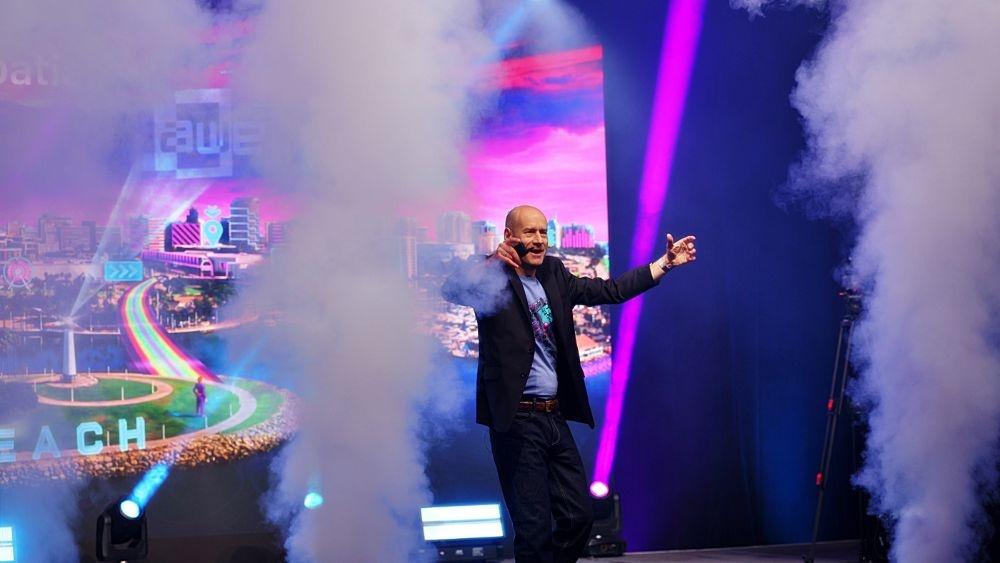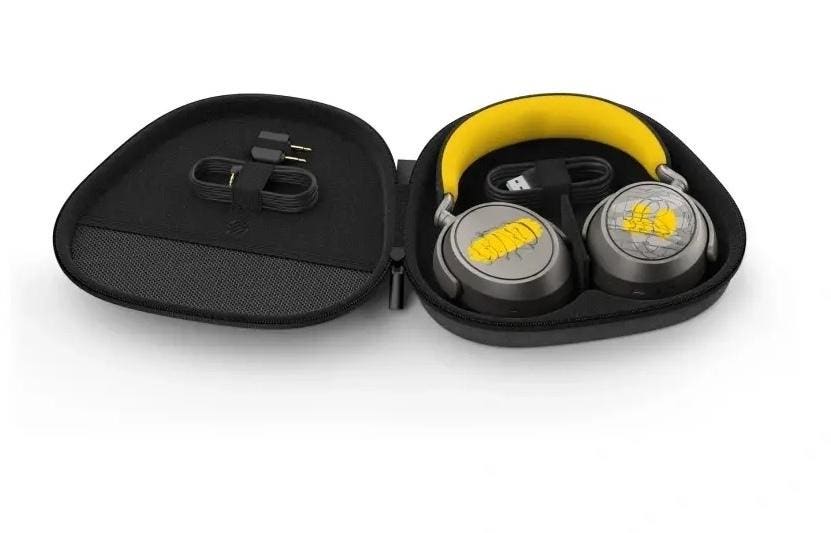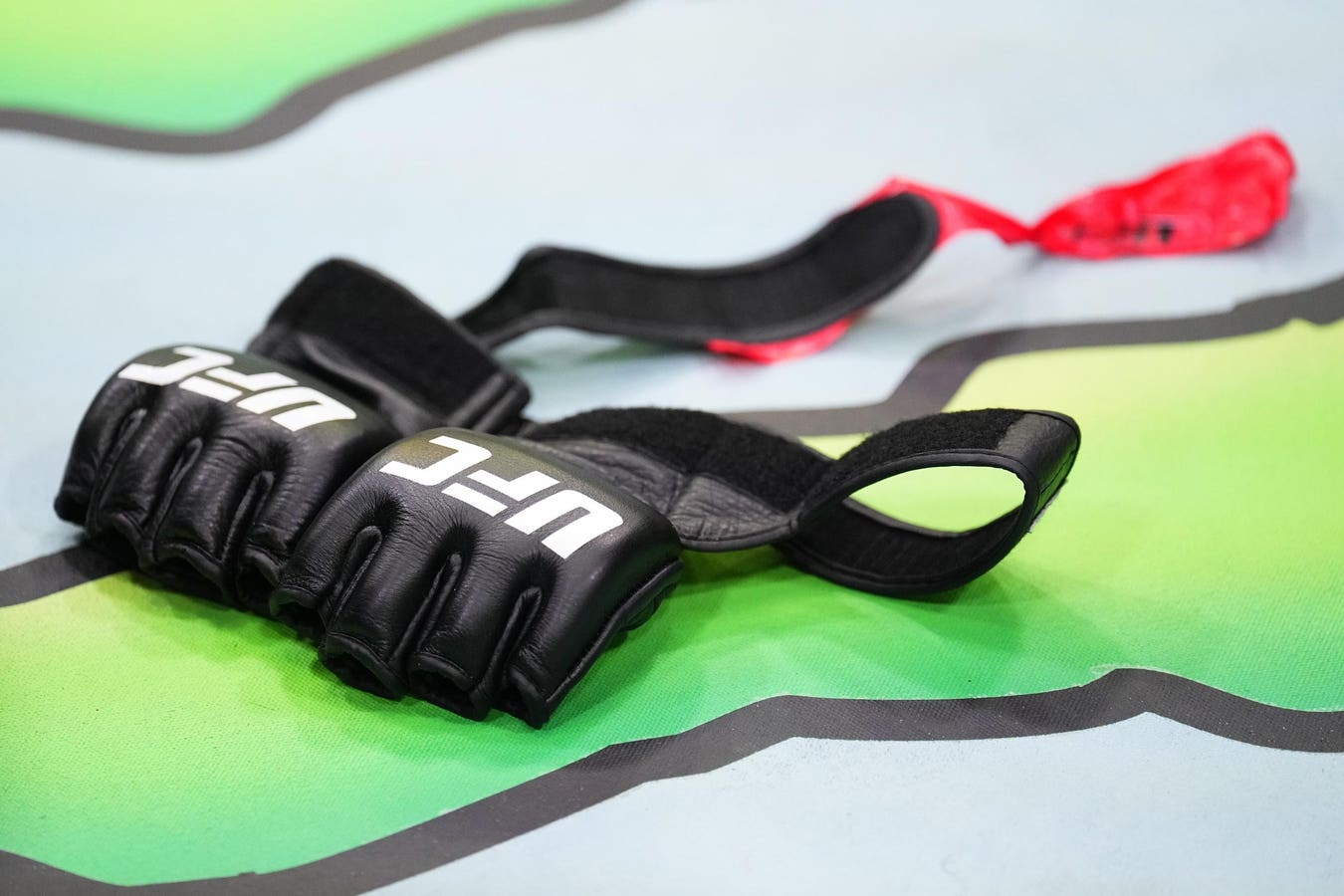The room was packed for Ori Inbar’s keynote.
Augmented World Expo (AWE) returns to Long Beach from June 10 to 12, 2025, with its most expansive and ambitious edition to date. Now in its 16th year, the XR industry’s flagship conference will host over 5,000 attendees, 250 exhibitors, and a speaker lineup that reads like a who’s who of immersive tech. As the spatial computing and AI worlds collide, AWE 2025 promises to be a milestone event in the evolution of real-world XR adoption.
Ori Inbar, AWE co-founder and CEO, celebrates his 15th annual keynote on stage at AWE 2024.
This year’s theme: XR is going mainstream. “The hardware is good enough, the tools are mature, and AI has lowered the barrier to entry,” AWE co-founder Ori Inbar said during a recent interview on the AI/XR Podcast. “There’s no excuse now. It’s a call to builders to create content for every person on this planet.”
Collage of people on the Expo floor.
AWE 2025 reflects that shift with expanded programming across the board. For the first time, both the conference and expo floor will run for a full three days, preceded by hackathons and a welcome party. Meta, Snap, Niantic, Google, Qualcomm, and XREAL are all sending top executives. Evan Spiegel (Snap), Nolan Bushnell (Atari), and Palmer Luckey (Anduril) headline a packed keynote slate.
Shots from AWE Expo 2021.
The show will spotlight three subcommunities shaping the future of XR. The new “Builder’s Nexus” showcases top teams from this year’s global hackathons, many of whom are using generative AI tools to build spatial experiences. A dedicated “Gaming Hub” will feature trailers and live demos from 10 VR studios, plus appearances by top content creators like Nacy, Nathie, and SadlyItsBradley. Enterprise XR, which now represents 71% of the market, will be served by a bespoke VIP program tailored to verticals such as healthcare, manufacturing, retail, and defense.
“We used to ask what the killer app for XR would be,” said Inbar. “Now we realize it’s AI itself—and vice versa. XR is the killer interface for AI.”
Montage of attendees experiencing XR at AWE 2024.
The synergy is most visible on the show floor, where nearly every exhibitor will feature some AI integration. Over 20 eyewear companies will be demoing headsets, glasses, and AI assistants. Snap’s next-generation Spectacles will be out in force, worn by hundreds of developers. Meta’s Ray-Ban smart glasses, which sold over 500,000 units in Q1 alone, signal a tipping point for mainstream wearable adoption.
And as always, AWE’s Playground will serve as the festival’s beating heart. Larger-than-life installations and interactive demos, including an expanded version of Brett Bushnell’s “Dream Park,” will draw crowds eager to experience the next frontier of computing.
Trying out the HoloLens at AWE 2017.
For newcomers and veterans alike, AWE remains the must-attend event for anyone working at the intersection of immersive media, AI, and real-world application. “You get a master’s degree in XR in three days,” said AR Insider’s Mike Boland . “There’s nothing else like it.”
AWE 2025 may not mark the beginning of the XR era—but it might be remembered as the year it stopped being a niche. Here is a quick preview of some brands and experiences at the show this year.
Niantic founder and CEO John Hanke.
Niantic Spatial, a newly created company spun out from Niantic Labs, is making a significant debut, with news of three important new partnerships, an invite-only geospatial AI agent and outdoor VPS demo. At its lounge area Niantic Spatial will offer 12 cutting-edge demos highlighting enterprise use cases for spatial technology in warehousing, spatial planning, and immersive entertainment. Brian McClendon will also be delivering a keynote.
At Qualcomm’s booth, attendees can check out MR & AR demos spanning various sectors, including entertainment, education, fitness and more. In addition, Ziad Asghar, SVP & GM of XR at Qualcomm will present a keynote titled, Accelerating the Spatial Computing Revolution for Developers and Enterprise. He’ll showcase how Qualcomm is powering the AI smart glass revolution and driving the technology necessary for AI glasses to be a stand-alone product with processing done all on-device, and he’ll highlight and demonstrate its technology leadership across the spectrum of spatial computing, enabling the experiences accessible today and building future proof solutions for the future.
Co-founder and Chief Executive Officer of Snap Inc Evan Spiegel (R) and France’s Secretary of State … More
AWE attendees are invited to explore the latest Snap Spectacles activations on the second floor of Long Beach Convention Center, available throughout the event. Snap CEO and Co-Founder Evan Spiegel will take to the Main Stage on Day 1 with exciting new announcements about Snap’s AR developer platform, and there will be other Snap talks throughout the show.
Xreal founder and CEO speaking at Augmented World Expo in Santa Clara, CA, June 2023.
XREAL will be showing its new smart glasses—Project Aura—designed specifically for the Android XR platform, for the first time anywhere. It will also be demoing the ultra-popular XREAL One Series AR glasses with spatial computing capabilities. Also available for demo will be the XREAL EYE, a modular camera attachment for the One Series.
Sony XYN (/zin/) will unveil its latest immersive technology. Attendees will get an exclusive first look at its newest innovations designed to redefine the boundaries of XR experiences. From cutting-edge hardware including a glasses-free 3D display, motion capture system and XR headsets to groundbreaking software solutions such as Motion Studio and Spatial Capture, Sony XYN will showcase transformative tools that enable the future of spatial computing and immersive content creation.
Auki Labs will showcase real-world solutions in the AR/AI and robotics space. Experience seamless AR navigation in the AWE venue by simply scanning a QR code—no app, no account setup, just magic. Used by retail chains in Europe and NA, Cactus enhances spatial reasoning for AI, humans, and robots, creating spatial tasks, analyzing location-based data, and facilitating robot deployments and interactions – bringing retail into the new world.
Cellid’s CEO Satoshi Shiraga will preview how Cellid’s latest waveguide and lens breakthroughs are helping push AR glasses toward truly wearable, consumer-grade form factors. It will showcase its ultra-thin, lightweight waveguide that improves visual clarity across diverse environments, reducing eye strain and enhancing long-term wearability, as well as next-Gen Precision Fit Lenses with enhanced resolution, compactness, and design flexibility for future AR glasses — optimized for all-day comfort and slimmer profiles. Cellid will also preview a collaboration with an AR glasses manufacturer and a next-gen headset prototype using Cellid’s optics.








